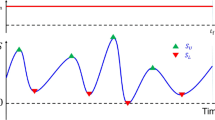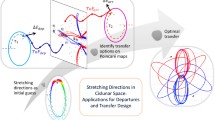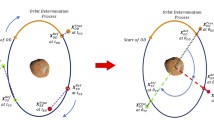Abstract
The methodologies for orbit maintenance continue to develop as the number of cislunar space missions grows. Many of the studies on stationkeeping within cislunar space assume a fixed number of evenly spaced correction maneuvers or plan maneuvers based on the control methodology and mission constraints. From these studies, the maneuver location and coast duration have been identified as essential design parameters that affect the cost of fuel consumption and aid in understanding when and where maneuvers should be placed. The Cauchy–Green tensor allows the analysis of combinations of these design parameters in the form of stability maps. This manuscript derives a modified Cauchy–Green tensor for one and two impulsive stationkeeping maneuvers. The stability maps obtained from the modified Cauchy–Green tensors are used to determine combinations of maneuver location and coast duration that minimize fuel consumption and the final position and velocity errors. In addition, a guidance policy, dependent on uncertainties and an initial state perturbation, is derived from the two-impulse stationkeeping analysis to determine whether performing a corrective maneuver is more beneficial to the overall system’s performance. The solutions obtained from this analysis yield a tool for mission design that is dependent mainly on the problem dynamics, navigation, and thrust uncertainties.










Similar content being viewed by others
Data Availability
The datasets produced in this study can be obtained from the corresponding author upon a reasonable request.
References
Shirobokov, M., Trofimov, S., Ovchinnikov, M.: Survey of station-keeping techniques for libration point orbits. J. Guid. Control Dyn. 40(5), 1085–1105 (2017). https://doi.org/10.2514/1.G001850
Folta, D., Vaughn, F.: A survey of earth-moon libration orbits: Stationkeeping strategies and intra-orbit transfers. In: AIAA/AAS Astrodynamics Specialist Conference and Exhibit (2004)
Berning Jr, A.W., Liao-McPherson, D., Girard, A., Kolmanovsky, I.: Suboptimal nonlinear model predictive control strategies for tracking near rectilinear halo orbits. arXiv preprint arXiv:2008.09240 (2020)
Farrés, A., Gao, C., Masdemont, J.J., Gómez, G., Folta, D.C., Webster, C.: Geometrical analysis of station-keeping strategies about libration point orbits. J. Guid. Control Dyn. 45(6), 1108–1125 (2022)
Bucci, L., Lavagna, M., Jehn, R.: Station keeping techniques for near rectilinear halo orbits in the earth-moon system. In: 10th International ESA Conference on Guidance, Navigation and Control (2017)
Muralidharan, V., Howell, K.C.: Stationkeeping in Earth-Moon near rectilinear halo orbits. In: AAS/AIAA Astrodynamics Specialist Conference (2020)
Davis, D.C., Phillips, S.M., Howell, K.C., Vutukuri, S., McCarthy, B.P.: Stationkeeping and transfer trajectory design for spacecraft in cislunar space. In: AAS/AIAA Astrodynamics Specialist Conference 8 (2017)
Guzzetti, D., Zimovan, E.M., Howell, K.C., Davis, D.C.: Stationkeeping analysis for spacecraft in lunar near rectilinear halo orbits. In: 27th AAS/AIAA Space Flight Mechanics Meeting, San Antonio, Texas, United States 160, pp. 3199–3218 (2017)
Subudhi, C.S., Vutukuri, S., Padhi, R.: A near fuel-optimal station-keeping strategy for halo orbits. In: 2020 59th IEEE Conference on Decision and Control (CDC), pp. 1478–1483 (2020). https://doi.org/10.1109/CDC42340.2020.9304327
Renault, C., Scheeres, D.: Optimal placement of statistical maneuvers in an unstable orbital environment. AIAA/AAS Astrodynamics Specialist Conference and Exhibit. https://doi.org/10.2514/6.2002-4725
Yan, H., Gong, Q.: Feedback control for formation flying maintenance using state transition matrix. J. Astron. Sci. 59, 177–192 (2012). https://doi.org/10.1007/s40295-013-0012-7
Farrés Basiana, A., Masdemont Soler, J., Gómez Muntané, G., Webster, C., Folta, D.C.: The geometry of station-keeping strategies around libration point orbits. In: Proceedings of the 70th Astronautical Congress, Vol. 19 (2019)
Station-keeping of libration point orbits by means of projecting to the manifolds. Acta Astronautica 163, 38–44 (2019). https://doi.org/10.1016/j.actaastro.2018.12.002. Fourth IAA Conference on Dynamics and Control of Space Systems (DYCOSS2018)
Vutukuri, S., Padhi, R.: An impulsive model predictive static programming based station-keeping guidance for quasi-halo orbits. Acta Astronaut. 188, 518–530 (2021). https://doi.org/10.1016/j.actaastro.2021.07.041
Folta, D.C., Woodard, M.A., Cosgrove, D.: Stationkeeping of the first Earth-Moon libration orbiters: The artemis mission. In: AAS/AIAA Astrodynamics Specialist Conference (2011)
Zhang, R., Wang, Y., Shi, Y., Zhang, C., Zhang, H.: Performance analysis of impulsive station-keeping strategies for cis-lunar orbits with the ephemeris model. Acta Astronaut. 198, 152–160 (2022). https://doi.org/10.1016/j.actaastro.2022.05.054
Renault, C.A., Scheeres, D.J.: Statistical analysis of control maneuvers in unstable orbital environments. J. Guid. Control Dyn. 26(5), 758–769 (2003). https://doi.org/10.2514/2.5110
Bonasera, S., Elliott, I., Sullivan, C., Bosanac, N., Ahmed, N., Mcmahon, J.: Designing impulsive station-keeping maneuvers near a Sun-Earth L2 halo orbit via reinforcement learning. In: AAS/AIAA Space Flight Mechanics Meeting (2021)
Pavlak, T., Howell, K.: Strategy for optimal, long-term stationkeeping of libration point orbits in the Earth-Moon system. In: AIAA/AAS Astrodynamics Specialist Conference (2012). https://doi.org/10.2514/6.2012-4665
Davis, D.C., Scheuerle, S.T., Williams, D.A., Miguel, F.S., Zimovan-Spreen, E.M., Howell, K.C.: Orbit maintenance burn details for spacecraft in a near rectilinear halo orbit. In: AAS/AIAA Astrodynamics Specialist Conference (2022)
LaFarge, N.B., Howell, K.C., Folta, D.C.: An autonomous stationkeeping strategy for multi-body orbits leveraging reinforcement learning. In: AIAA SCITECH 2022 Forum (2022). https://doi.org/10.2514/6.2022-1764
Landau, D.: Efficient maneuver placement for automated trajectory design. J. Guid. Control Dyn. 41(7), 1531–1541 (2018). https://doi.org/10.2514/1.G003172
Muralidharan, V., Howell, K.C.: Leveraging stretching directions for stationkeeping in Earth-Moon halo orbits. Adv. Space Res. 69(1), 620–646 (2022). https://doi.org/10.1016/j.asr.2021.10.028
Short, C.R., Howell, K.C.: Lagrangian coherent structures in various map representations for application to multi-body gravitational regimes. Acta Astronaut. 94(2), 592–607 (2014). https://doi.org/10.1016/j.actaastro.2013.08.020
Oshima, K., Campagnola, S., Yam, C.H., Kayama, Y., Kawakatsu, Y., Ozaki, N., Verspieren, Q., Kakihara, K., Oguri, K., Funase, R.: Equuleus mission analysis: Design of the transfer phase. In: International Symposium on Space Technology and Science, ISTS-2017-d-159, Ehime, Japan (2017)
Baresi, N., Dei Tos, D.A., Ikeda, H., Kawakatsu, Y.: Trajectory design and maintenance of the Martian moons exploration mission around Phobos. J. Guid. Control Dyn. 44(5), 996–1007 (2021). https://doi.org/10.2514/1.G005041
Spreen, C., Howell, K.C., Marchand, B.: Node placement capability for spacecraft trajectory targeting in an ephemeris model. In: AAS/AIAA Astrodynamics Specialist Conference, Vail, Colorado (2015)
Bai, X., Junkins, J.: Modified Chebyshev-Picard iteration methods for station-keeping of translunar halo orbits. Math. Probl. Eng. (2012). https://doi.org/10.1155/2012/926158
Davis, D.C., Bhatt, S., Howell, K.C., Jang, J.-W., Whitley, R.J., Clark, F., Guzzetti, D., Zimovan, E.M., Barton, G.: Orbit maintenance and navigation of human spacecraft at cislunar near rectilinear halo orbits. In: 27th AAS/AIAA Space Flight Mechanics Meeting, San Antonio, Texas, February 5-9, 2017 (2017)
Author information
Authors and Affiliations
Corresponding author
Ethics declarations
Conflict of interest
On behalf of all authors, the corresponding author states that there is no conflict of interest
Additional information
Publisher's Note
Springer Nature remains neutral with regard to jurisdictional claims in published maps and institutional affiliations.
Appendices
Appendix A: Jacobian Matrix for the CR3BP
Appendix B: Stability Maps for Three Orbit Periods
From an automation perspective, maintaining consistent maneuver locations across multiple orbit revolutions is desirable. Given the periodic nature of orbits in the CR3BP, it is expected that the stability map patterns repeat. This is demonstrated by regenerating the stability maps in Figs. 5 and 6 for three orbit revolutions, as illustrated in Figs. 11 and 12 for the NRHO and \(L_2\) Lyapunov, respectively. Similarly, Figs. 7 and 8 exhibit the same behavior, as evident in Figs. 13 and 14 for the NRHO and \(L_2\) Lyapunov, respectively.
Rights and permissions
Springer Nature or its licensor (e.g. a society or other partner) holds exclusive rights to this article under a publishing agreement with the author(s) or other rightsholder(s); author self-archiving of the accepted manuscript version of this article is solely governed by the terms of such publishing agreement and applicable law.
About this article
Cite this article
Rivera Lopez, K., Holzinger, M. Statistical Analysis of Optimal Stationkeeping Location and Coast Duration Using Stretching Directions. J Astronaut Sci 71, 7 (2024). https://doi.org/10.1007/s40295-023-00427-2
Accepted:
Published:
DOI: https://doi.org/10.1007/s40295-023-00427-2








